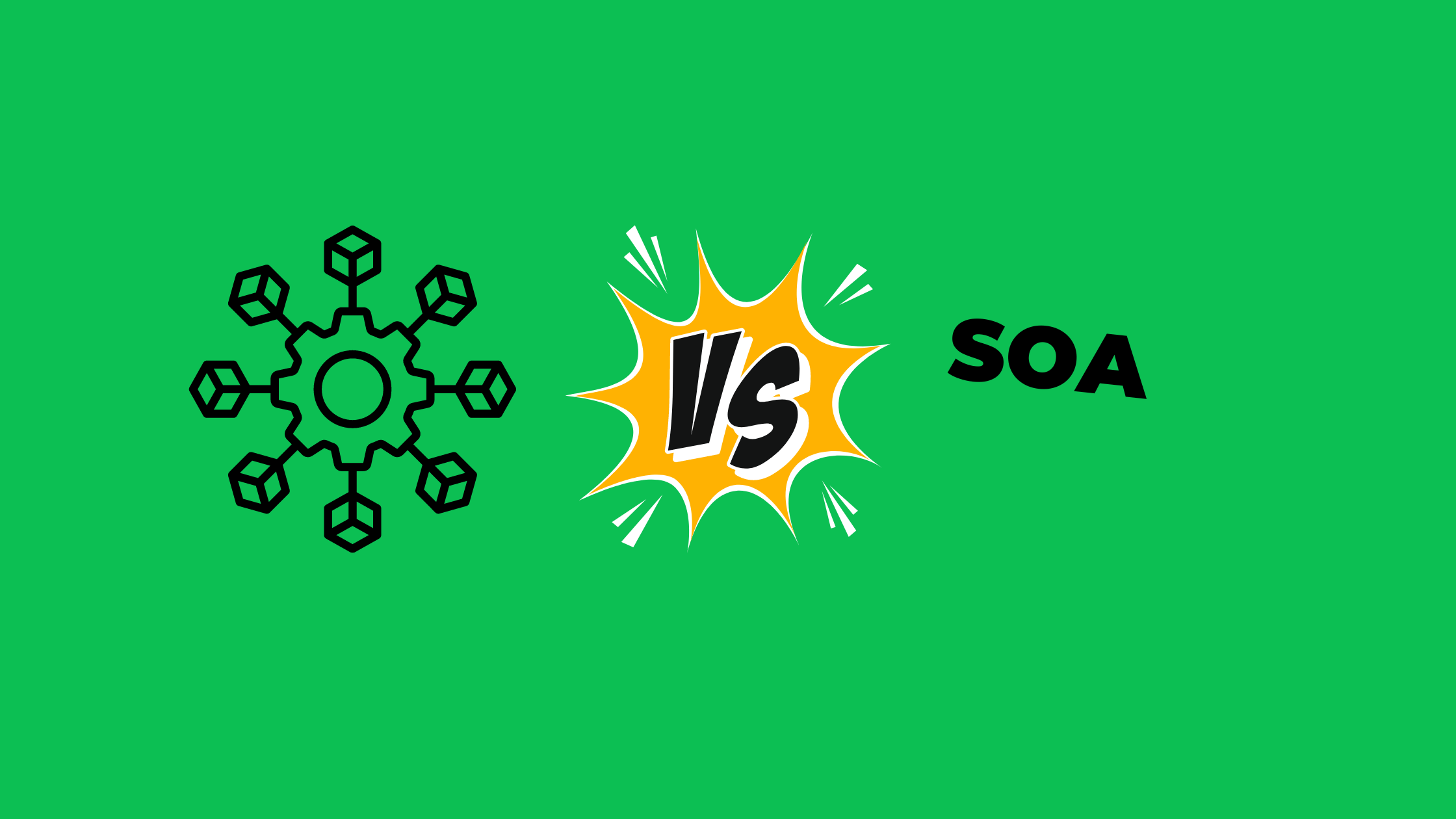SOA vs Microservices: Understanding Modern Architectural Approaches
In the ever-evolving landscape of software development, choosing the right architectural style is crucial for building scalable, maintainable, and efficient applications. Two popular approaches that have gained significant attention are Microservices and Service-Oriented Architecture (SOA). While both aim to break down complex applications into more manageable components, they differ in various aspects. This comprehensive guide explores the differences between SOA vs microservices, their strengths and weaknesses, and helps you determine which architecture is best for your business.
Understanding Service-Oriented Architecture (SOA)
Service-Oriented Architecture (SOA) emerged in the early 2000s as a way to design software systems by providing services to other components via a communication protocol over a network. SOA was designed to address the challenges of monolithic architectures by promoting modularity, reusability, and interoperability.
Key Characteristics of SOA
- Service-based: SOA decomposes functionality into a suite of services.
- Interoperability: Services communicate using standard protocols.
- Loose coupling: Services are independent of each other.
- Abstraction: Services hide their logic from the outside world.
- Reusability: Services can be reused across different applications.
- Discoverability: Services can be discovered and used by other components.
Components of SOA
- Services: Self-contained units of functionality.
- Service Registry: A directory of available services.
- Enterprise Service Bus (ESB): Facilitates communication between services.
- Service Contracts: Define how services interact.
Understanding Microservices Architecture
Microservices architecture is a more recent approach that takes the concept of modularization even further. It’s an architectural style that structures an application as a collection of small, loosely coupled services, each responsible for a specific business function.
Key Characteristics of Microservices
- Decomposition: Applications are broken down into small, independent services.
- Autonomy: Each microservice is developed, deployed, and scaled independently.
- Decentralization: Microservices are distributed and decentralized.
- Polyglot: Different technologies can be used for different microservices.
- Resilience: Failure in one service doesn’t affect the entire system.
- Continuous Delivery: Enables frequent and reliable software releases.
Components of Microservices Architecture
- Microservices: Small, independent services.
- API Gateway: Entry point for clients, handles routing and aggregation.
- Service Discovery: Mechanism for services to locate each other.
- Message Broker: Facilitates asynchronous communication between services.
- Containers: Lightweight, portable environments for running microservices.
SOA vs Microservices: Key Differences
While SOA and microservices share some similarities, they differ in several important aspects:
1. Granularity
SOA: Services in SOA can range from fine-grained to coarse-grained. Microservices: Microservices are typically more fine-grained, focusing on a single business capability.
2. Integration
SOA: Often relies on an Enterprise Service Bus (ESB) for integration. Microservices: Uses lightweight protocols like REST or messaging queues.
3. Data Storage
SOA: May share databases between services. Microservices: Each microservice typically has its own database, following the bounded context principle.
4. Deployment
SOA: Services are often deployed as part of larger, monolithic applications. Microservices: Each microservice can be deployed independently, allowing for more flexible and frequent deployments.
5. Technology Stack
SOA: Often uses a uniform technology stack across services. Microservices: Allows for polyglot architecture, using different technologies for different services.
6. Governance
SOA: Typically has centralized governance. Microservices: Favors decentralized governance, giving teams more autonomy.
7. Service Reusability
SOA: Emphasizes service reuse across the enterprise. Microservices: Focuses on service independence rather than reusability.
Advantages of SOA
- Reusability: Services can be reused across different applications, promoting efficiency.
- Standardization: Promotes use of standard protocols and interfaces.
- Scalability: Services can be scaled independently to some extent.
- Integration: Facilitates integration with legacy systems.
- Business-IT Alignment: Services are aligned with business processes.
Advantages of Microservices
- Agility: Enables rapid development and deployment of new features.
- Scalability: Individual services can be scaled independently, offering better resource utilization.
- Technology Flexibility: Different services can use different technologies, allowing teams to choose the best tool for each job.
- Resilience: Failure in one service doesn’t bring down the entire system.
- Ease of Understanding: Smaller codebases are easier to understand and maintain.
Challenges of SOA
- Complexity: Integration and management of services can become complex.
- Performance: The ESB can become a bottleneck and a single point of failure.
- Governance: Centralized governance can slow down development.
- Cost: Implementing and maintaining SOA can be expensive.
Challenges of Microservices
- Distributed Systems Complexity: Managing distributed systems is challenging.
- Data Consistency: Maintaining data consistency across services is difficult.
- Testing: Testing microservices-based applications can be complex.
- Operational Overhead: Managing multiple services increases operational complexity.
When to Choose SOA
SOA might be the right choice when:
- You need to integrate multiple complex, heterogeneous systems.
- Service reuse across the enterprise is a priority.
- You have a large, complex application that needs to be modernized gradually.
- You need to maintain centralized control and governance.
When to Choose Microservices
Microservices might be the better option when:
- You’re building a new application from scratch.
- You need to scale parts of your application independently.
- You want to enable rapid, frequent releases of new features.
- Your team is comfortable with distributed systems and DevOps practices.

The Evolution from SOA to Microservices
Microservices architecture can be seen as an evolution of SOA. Both architectural styles share the goal of breaking down complex applications into more manageable components. However, microservices take this concept further by emphasizing smaller, more independent services and addressing some of the challenges faced in SOA implementations.
The transition from traditional monolithic architectures to SOA, and then to microservices, reflects the software industry’s ongoing quest for more flexible, scalable, and maintainable systems.
Communication Protocols
SOA and microservices differ in their approach to communication:
SOA: Often uses heavier protocols like SOAP (Simple Object Access Protocol) or the Advanced Message Queuing Protocol (AMQP).
Microservices: Typically use lightweight protocols like REST (Representational State Transfer) or gRPC.
Interface Design
SOA: Often uses WSDL (Web Services Description Language) to define service interfaces.
Microservices: Commonly use API specifications like OpenAPI (formerly Swagger) for RESTful services.
Development and Deployment
SOA: May involve longer development cycles and less frequent deployments.
Microservices: Embraces continuous integration and continuous deployment (CI/CD), allowing for rapid and frequent updates.
Choosing the Right Architecture for Your Business
Selecting the best architectural approach depends on various factors:
- Business Requirements: What are your specific business needs and goals?
- Existing Infrastructure: What systems do you already have in place?
- Team Skills: What is your team’s expertise and comfort level with different architectures?
- Scalability Needs: How much and in what ways do you need your system to scale?
- Development Speed: How quickly do you need to develop and deploy new features?
- Budget: What resources are available for implementation and maintenance?
Conclusion
Both SOA and microservices offer valuable approaches to building complex software systems. SOA provides a structured way to integrate diverse systems and promote service reuse across an enterprise. Microservices, on the other hand, offer increased agility, scalability, and technological flexibility.
The choice between SOA and microservices – or a hybrid approach – should be based on a careful analysis of your specific needs, constraints, and goals. Remember that no architectural style is a silver bullet; each comes with its own set of trade-offs.
For a deeper understanding of Service-Oriented Architecture, you can explore AWS’s comprehensive guide on What is Service-Oriented Architecture?. Additionally, our own in-depth article on SOA Architecture provides further insights into this architectural style.
If you’re leaning towards microservices, the Microservices.io website is an excellent resource, offering patterns, guides, and best practices for implementing microservices architecture.
As you consider which architecture is best for your business, it’s essential to stay informed about the latest developments in software architecture. The field is continually evolving, and new approaches and best practices are always emerging.
Ultimately, the goal is to choose an architecture that enables you to build and maintain software systems that are efficient, scalable, and aligned with your business objectives. Whether you opt for SOA, microservices, or a hybrid approach, the key is to implement it thoughtfully and adapt as your needs change.
By understanding the differences between SOA and microservices, their respective strengths and challenges, you’ll be better equipped to make an informed decision and set your software projects up for success in the ever-changing landscape of software development.
If you’re looking for expert guidance in implementing either SOA or microservices architecture, or need assistance with custom software development tailored to your specific needs, don’t hesitate to explore our Custom Software Development Services. Our team of experienced developers and architects can help you navigate the complexities of modern software architecture and build robust, scalable solutions for your business.
Remember, the right architecture can be a game-changer for your organization, driving efficiency, scalability, and innovation. Take the time to evaluate your options carefully, and don’t hesitate to seek expert advice when needed. Your future self – and your business – will thank you for it.












